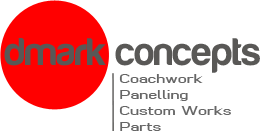Home > What We Do > Panelling
-
- Tweet
- youtube

-

- TEMPLATES
Pattern-making, bucks and templates
We often have to make wooden bucks and templates before we start the metalwork. The set of bucks shown (left) are for a pair of front Bentley wings.
Patterns, templates and bucks (for larger items) are an essential part of panelmaking.
Another example is the buck that had to be constructed for the Ferrari TRI61 LM build (right).
- WHEELING
Wheeling on the English Wheel
When necessary we stretch, curve and shape the panel using our English Wheel. It’s easy to over stretch or dent the metal but the trick is to gradually work the material with a firm grip but a light touch allowing the wheels to do the shaping.
The clever bit is being able to shrink the metal in the wheel..!
The panel Don’s wheeling in the photo is an aluminium section for a vintage Lagonda mudguard wing.
- PLANISHING
Hammer, dollies, flippers and files
The key thing to remember when it comes to planishing is ‘low spots up and high spots down’ the better you can do this the less filing you’ll have to do. The majority of the time we tap-up using our hand tools but we do have a small air hammer which from time to time proves very handy indeed.
The panel pictured (left) is part of a newly created vintage Lagonda mudguard wing.
- CONTOURS
Double curves and symmetrical shapes
Bringing all our skills together we eventually start to see the panels and sections coming together and the formation of the overall panel. We predominantly butt weld together panels with oxy/acetylene and minimal rod use. Conquering double curves and awkward assemblies are just part of the panelmaking art form.
See more of these clean polished contours in our Austin Healey 3000 gearbox cover photo gallery.
- LOUVRES
Custom single and double louvres
We’ve stamped out hundreds of louvres over the years and have two fly-presses one with a deep throat, vital when the louvres aren’t near the edge of the panel and another smaller short throated fly-press. We also have other press tools which we can adapt to suit.
The louvres in the bonnet (left) are unique because each one is slightly smaller than the next. A special tool was made and machined down after each louvre cut, needless to say once the tooling was machined there was no going back!
See more of these bonnet louvres in our 1919 Ballot online photo gallery.

 Latest news updates
Latest news updates